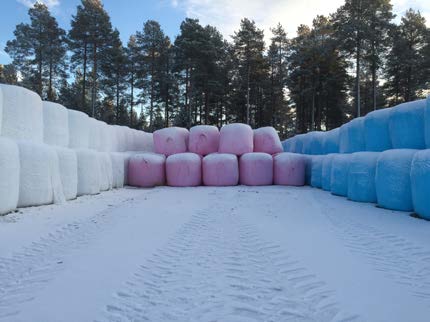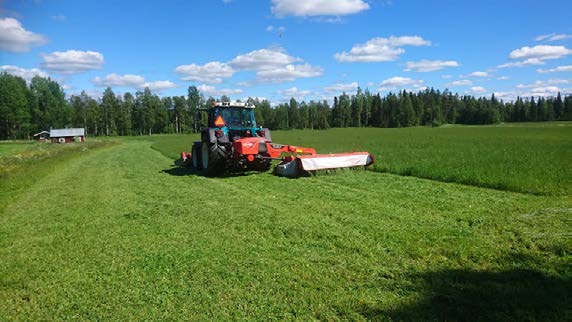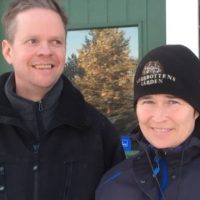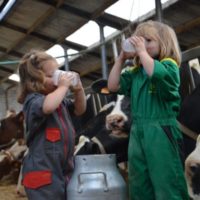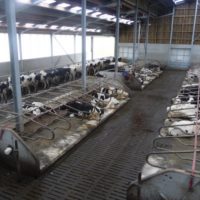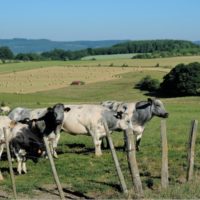Intensive forage harvesting system more profitable
Three cuts gave better forage quality and better returns
Farm: “Luttugården”
Location: Norrbotten, Sweden
Case study
 Intensive forage harvesting system more profitable (.pdf)
Intensive forage harvesting system more profitable (.pdf)
Description
Background
Luttugården Farm lies within the Arctic Circle, near Övertorneå in Norrbotten county. The farm has around 65 dairy cows of the Swedish Red breed that produce 11200 kg milk per cow and year. The cows are milked in a robot system and kept in a loose house built in 2004. The farm also rears 100 of its own and bought-in steers for slaughter, in a fattening house built in 2011. The workforce consists of one full-time employee and 1.5 fulltime family members. During the growing season, the farm also hires temporary staff at an hourly rate for some of the field work.
The farm has 258 ha of arable land. It owns only 30 ha of this land, while the remainder is leased. The soils are mainly (2/3 of area) silt-based river valley sediment deposited after the last ice age around 8500 years ago. A considerable proportion (1/3) are also organic (>20% humus), with a high humus content that can reach 60–70% in some fields.
Climate and sunlight
The climate in the region can be defined as cold continental, with annual precipitation of 500–600 mm. A characteristic feature is the long winter, with snow cover for around 200 days per year and average snow depth of 70 cm. Spring tillage usually starts during late May and is completed in June. In winter, the temperature can fall to -40°C, while the maximum temperature in summer can be around 32°C.
Another important factor for crop growth in the region is the long summer days, i.e. many hours of sunlight when the sun does not sink below the horizon during the growing season. Up to 470 sunlight hours have been recorded in Norrbotten county and therefore the grass grows around the clock. The peak solar radiation is equivalent on average to 8000 W/m2 of global insolation, 13000 W/m2 of direct insolation and 4000 W/m2 of diffuse insolation.
Detailed description
The number of forage cuts on the farm has been increased from two to three per year. The seed mix used for grassland consists of timothy, meadow fescue/tall fescue, red clover and sometimes white clover, with timothy as the base (70%). The timothy variety SW Jonatan was used in the past, but has been replaced with Grindstad, which is earlier in its development and produces good regrowth. On Luttugården Farm, it was estimated that a production increase of 200–300 kg milk per cow and year would cover the costs of the extra cut.
Cut timing and storage method
The first cut is generally taken between 18 and 22 June and a careful assessment is made before this. For example, samples are taken for analysis 2–3 weeks before the first cut, the temperature sum is calculated via a decision support tool for grassland forecasting (www.vallprognos.se) and grass growth is monitored. When the timothy reaches the earing stage, a cut is taken. The second cut is taken 5 weeks later and a third cut after an additional 6 weeks. By the time the last cut is taken, the nights have started to get longer again.
All forage is stored in round bales. Since some of the land leased by the farm is far away, this is the most flexible system and has the lowest production costs under the prevailing circumstances.
Crop rotation and seed mix
Only forage is grown on the farm. A four-year crop rotation is applied for temporary grasslands on around 140 ha (Table 1). In addition, there are around 60–70 ha of grazing, including both semi-natural grasslands (44 ha) on shore meadows around the lake and grazed temporary grasslands (around 19 ha) near the farm centre. The remaining area consists of older leys that produce forage for dry cows and heifers and are harvested extensively, in this case 1–2 times per year.

The ley is undersown in a mixture of spring wheat and peas. The seed rate for this crop is usually 150 kg/ha and it is ensiled after harvest and fed together with the forage. On fields with a higher humus content and lower pH, the peas are replaced by vetch and the seed rate is reduced to 100 kg/ha. The insown ley consists of a mixture from Lantmännen that is adapted for northern Sweden (Table 2). The seed rate for this is usually around 23 kg/ha. On soils with very high humus content, alsike clover is sometimes used since red clover has difficulty establishing on these soils. Having white clover in the seed mixture compensates for the decline in red clover during the third ley year, so a few percent are sometimes included in the mixture.

Fertilisation plan
Luttugården Farm applies a cropping schedule with planned fertiliser doses. It is now converting to organic and as a result of that is returning to a two-cut system. The fertiliser plan (Table 3) is based on fertilisation in the three-cut system, which is the focus of the innovation, and involves use of the farm’s own manure and purchased commercial fertiliser as a complement. No pesticides are used on the farm, even on the conventionally managed area.

Results
Milk yield from the farm’s cows increased by at least 500 kg per cow and year with the three-cut system, which was more than the amount needed to cover the costs of the extra cut (200–300 kg). For the farm, this meant that in addition to more revenue from the milk itself, it also received a higher production subsidy, since the ‘national subsidy’ for this area is coupled to milk yield. It has therefore been profitable to intensify the forage harvesting system.
Yield and forage analyses
No direct increase in yield was observed as a result of the extra cut. The forage yield in conventional production was around 5000 kg DM/ha, which corresponds to the average yield level for Norrbotten county. Yield can vary between different farms in the region, depending on their soil type, their position in the landscape and the status of their grassland. Luttugården Farm has fine-textured soils but lies slightly inland and has a large proportion of organic soils, which means that forage yield is reasonably large. However, the quality of the forage improved with three cuts instead of two (Table 4).

The higher profitability with three cuts confirms findings in field trials at Umeå, which show better profitability in milk production with such a forage harvesting system (Nilsson, 2011). The trials, which ran for three seasons (2006–2008), found that the three-cut system gave larger total yield than the two-cut system, provided that the third cut was delayed (Table 5). Forage quality also improved, which reduced the feed costs per kg of milk produced since the concentration ratio could be reduced. The production per kg milk was also lower in the intensive three-cut system. When the time of the third cut was not delayed, the total yield was greater with two cuts (Gunnarsson et al., 2014).
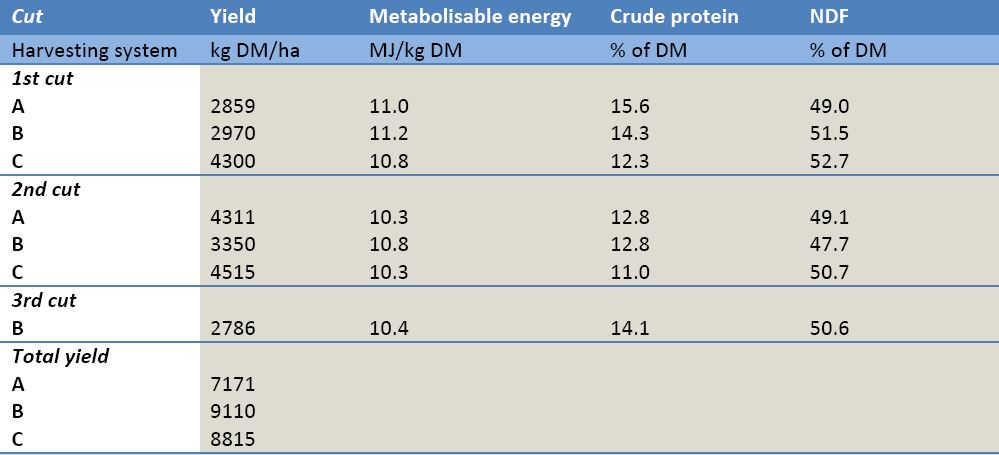
Adoption criteria
If three cuts instead of two work well at this high latitude, they can work everywhere, as long as the ley consists of species capable of fast growth in all cuts. Recent climate change has also improved the conditions for three cuts per season.
Future prospects
Climate change will mean a longer growing season for the northern hemisphere. Already the growing season is around two weeks longer for farmers in northern Sweden. This should result in more farmers deciding to convert to a more intensive forage harvesting system in future. The autumns have become milder and the grass grows for a longer period, so in order to decrease the risk of winter kill by fungi under the snow, the timing of the last forage cut of the season is important.
References
- Gunnarsson C., Nilsdotter-Linde N. & Spörndly R. 2014. Two, three or four harvests per year – feed value and costs for cows. JTI – Swedish Institute of Agricultural and Environmental Engineering. Agriculture and Industry 419. Uppsala. 25 pp.
http://www.jti.se/index.php?page=rapporter-lantbruk-industri English summary.- Nilsson, B., Ericson, L. & Martinsson, K. 2011. Vallens avkastning and kvalitet vid olika skördesystem i northern Sweden. Swedish University of Agricultural Sciences. Nytt från institutionen för norrländsk jord-bruksvetenskap 1, 4 pp.
Additional information
| Farming system | conventional farming, organic farming |
|---|---|
| Domains of innovation | farm system, forage mixture |
| Main types of animal | dairy cattle |
| Country | Sweden |
| Product type | Case study |
| Language | English |
| Author | Hulda Wirsén |

